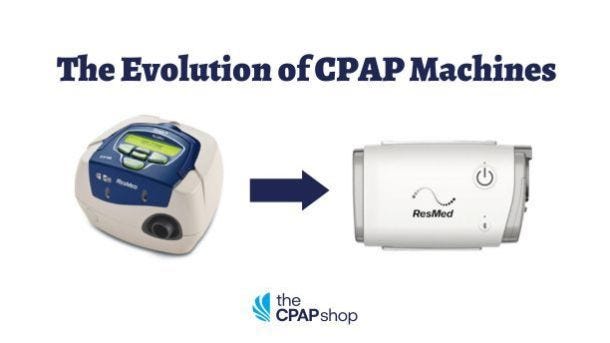The Evolution of CPAP Machines
This post was originally posted on October 31, 2013, and updated on May 5, 2022.
CPAP machine technology helps millions of people manage their sleep apnea. But the earliest CPAP machines were actually created for dogs with respiratory issues. This successful treatment helped many breeds of dogs who naturally have difficulty breathing. The inventors then refined their device when they realized it could also be applied to humans.

The Invention of CPAP Machines – 1981
Dr. Colin Sullivan was still relying on primitive apparatus as he converted his dog respiratory device to a human respiratory device. He used a vacuum cleaner motor to drive the pressurized air through a hose into a breathing mask.
Initially sleep apnea patients had to be confined to a lab to receive a similar type of treatment. But Dr. Sullivan’s invention was the first to allow sleep apnea patients to begin treating themselves in the comfort of their own homes.
Introducing CPAP Passover Humidifiers – 1990
One of the problems that plagued early CPAP therapy machines was that the dry, pressurized air left patients with dry sore throats and dry nasal passages, which often led to sinus infections. In 1990, the CPAP equipment manufacturer Fisher and Paykel introduced a humidifier that injected moisture into the pressurized airflow to reduce the side effects. Most patients today couldn’t conduct their CPAP therapy without the added benefit of humidified air.
Introducing CPAP Integrated Humidifiers – 1995
CPAP equipment designers and engineers continued to refine the technology to provide more comfort and ease for users. The essential humidifier was soon integrated into the CPAP machine, reducing the need for an external attachment. The humidifier could also now heat the moisture injected into the pressurized air, so patients experienced soothing warm air as they breathed.
The heated, moist air took patients to a new level of comfort and became an integral part of most CPAP machines moving forward.
Auto-titrating CPAP Machines – 2007
Another challenge facing both CPAP machine developers and patients was variations in air pressure over the course of a night. Because air pressures vary during therapy, patients were not always receiving their designated pressure levels consistently during therapy. The auto-titrating CPAP machine was a new invention that automatically adjusted to the accurate pressure setting based on the needs of the patient. Patients could now stay CPAP compliant without making any adjustments to their CPAP machine.
The Evolution Of CPAP
Technical Improvements
Technical advancements continued, including the development of a heated tube. The humidifier often caused condensation in the tube which would lead to water dripping into the CPAP mask. A heated tubed prevented condensation from forming and kept CPAP therapy comfortable. Mask design also continued to evolve, providing more secure seals, comfort, and fitting options for sleep apnea patients.
Ramp Pressure
Ramp pressure was a breakthrough technology that helped new patients adapt to CPAP therapy. The CPAP machine feature would start with a lower pressure setting that allowed a patient to breathe easily while they were falling asleep. The machine would then “ramp” up to the prescribed setting later without causing any discomfort to patients as they were already fast asleep.
Smart CPAP Machines
CPAP machines were also becoming smarter. Using the latest in digital technology, CPAP machines could now track sleep data. Patients could review changing patterns in their sleep by reviewing the data and share that information with their doctors. Smart sensors could also alert users to mask leaks and other issues.
Portable Travel CPAP Machines
As CPAP therapy became more sophisticated, the machines became more portable. Now patients with sleep apnea did not have to forgo treatment while away from home. Travel CPAP machines were smaller, lighter, and more compact than home units while providing all the benefits of home CPAP therapy. Many machines became FAA approved for use on commercial airliners.
Smallest Travel CPAP Machine - ResMed AirMini
ResMed introduced the smallest travel CPAP machine ever. Weighing in at only 10.6 ounces, this travel CPAP machine could be easily packed and carried anywhere. Customers raved that this small CPAP unit had all the favorite benefits of their home units.
The ResMed AirMini Auto Travel CPAP includes:
- Auto-adjusting pressure-so users were always CPAP compliant during therapy.
- Auto Ramp-users could go from lower pressure settings to prescribed settings without adjustment.
- Smart stop and start - provides auto start and stop of the machine by detecting your breath
- Exhalation pressure relief-helped modify exhaled breath pressure, which is often more difficult for users.
- Sleep tracking- gathering all your sleep data no matter where you travel.
- Built-in humidification-so CPAP therapy on the road is always comfortable.
Customers continue to leave five-star reviews.
- "Just what I needed" - Review by Nick
- "Awesome Travel CPAP" - Review by Cueball
- "Most comfortable nose pillow and headgear and easy to pack." - Review by Nize
Where Can I Buy CPAP Machines for CPAP Therapy?
You can find CPAP machines along with masks and accessories at The CPAP Shop. Our knowledgeable staff can assist you with finding the ideal CPAP machine for your needs. Give us a call at 866-414-9700.




